The Ceylon Defence Force (CDF) was established in 1910 by the Ceylonese legislation Ceylon Defence Force Ordinance, which reformed the Ceylon Volunteer Force (CVF) that existed previously as the military reserve in the British Crown colony of Ceylon. At the time of forming it was only a reserve force but soon developed into a regular force responsible for the defence of Ceylon. The CDF was under the command of the General Officer Commanding, Ceylon of the British Army in Ceylon if mobilised. However mobilisation could be carried out only under orders from the Governor.
After the outbreak of the Second World War, in the British Crown Colony of Ceylon, the government of Sir Don Baron Jayatilaka assured the British King and his government of its continued support.
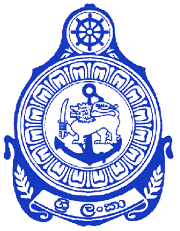
The Sri Lanka Navy (SLN) is the naval arm of the Sri Lanka Armed Forces and is classed as the country's most vital defence force due to its island geography. It is responsible for the maritime defence of the Sri Lankan nation and its interests. The role of the Sri Lanka Navy is to conduct operations at sea for the defence of the nation and its interests and conduct prompt and sustainable combat operations at sea in accordance with the national policies.

The Sri Lankan Armed Forces award medals and their associated ribbon bars in recognition of various levels of service, personal accomplishments and commemorative events while a regular- or volunteer serviceperson is a member of the Sri Lanka Army, Sri Lanka Navy and the Sri Lanka Air Force. Together with military badges, such awards are a means to outwardly display the highlights of a serviceperson's career.
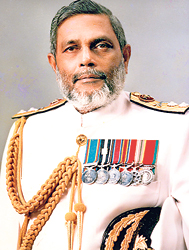
Admiral Wannakuwatta Waduge Erwin Clancy Fernando VSV, USP, MNI was a senior Sri Lanka Navy officer. He served as the Commander of the Sri Lanka Navy from 1 November 1991 to 16 November 1992, when he was assassinated by the LTTE he was the most senior officer in the Sri Lankan armed forces to be killed in the line of duty.

The Sri Lanka Volunteer Naval Force (SLVNF) is the active-duty volunteer reserve force of the Sri Lanka Navy. The SLVNF, which consists of the volunteer force and the volunteer reserve is separate from the Regular Naval Force, which consists of the Regular Force consisting of professional naval officers and sailors, and its Regular Reserve, which comprises personal who have a mobilization obligation following their service in the regular force.

Admiral of the Fleet Wasantha Kumar Jayadeva Karannagoda, RSP, VSV, USP, MRIN, MNI is a Sri Lankan naval officer. He served as the Commander of the Sri Lankan Navy during the last phase of the Sri Lankan Civil War and Governor of North Western Province, Sri Lanka from 2021 to 2023.
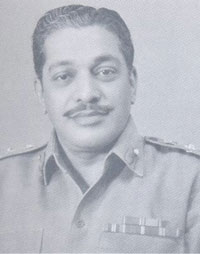
General Deshamanya Don Sepala Attygalle, was a Sri Lankan army officer, civil servant and diplomat. The longest serving Commander of the Sri Lankan Army (1967–1977), he went on to serve as the Permanent secretary to the Ministry of Defence and Sri Lankan High Commissioner to the United Kingdom.
Rear Admiral Rajanathan Kadiragamar, MVO was a Ceylonese flag officer. He was the second Ceylonese Captain of the Royal Ceylon Navy from 1960 to 1970 and as such the longest serving Commander of the Navy.
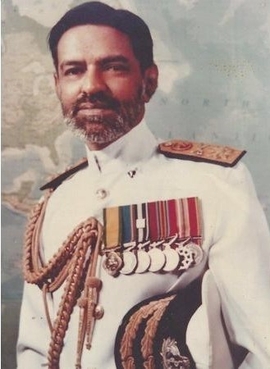
Vice Admiral A. H. Asoka de Silva, VSV was the Commander of the Sri Lanka Navy from 1983 to 1986. He was the first Sri Lankan Ambassador to Cuba.
Admiral Deshamanya D. Basil Gunasekara was the Commander of the Sri Lanka Navy from 1973 to 1979.

The Sri Lanka Armed Forces is the overall unified military of the Democratic Socialist Republic of Sri Lanka encompassing the Sri Lanka Army, the Sri Lanka Navy, and the Sri Lanka Air Force; they are governed by the Ministry of Defence (MoD). The three services have around 346,700 active personnel; conscription has never been imposed in Sri Lanka. As of 2021 it is the 14th largest military in the world, with 1.46% of the Sri Lankan population actively serving.
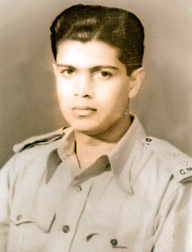
Lieutenant Colonel Dr. Anthony St. Clare Rex de Costa, MBE, CAVF was a renowned Sri Lankan medical doctor and soldier. He was the commanding officer of the Ruhunu Regiment, a doctor in the Ceylon Defence Force during World War II and a vice president of the World Veterans Federation. He was assassinated by the JVP during the 1971 Insurrection.
Vice Admiral Hikkaduwage Ananda Silva, VSV was a Sri Lankan senior naval officer who was the 11th Commander of the Sri Lankan Navy.
Rear Admiral D. V. Hunter was a Sri Lankan naval officer, who served as the 7th Commander of the Sri Lankan Navy.
Rear Admiral Gerard Royce Maxwell De Mel, OBE was a Ceylonese admiral. He was the Captain of the Royal Ceylon Navy from 1955 to 1961, the first Ceylonese to hold the post. He was accused and convicted in the 1962 Ceylonese coup d'état attempt.
Major Basil Cholmondel Henricus was a Sri Lankan boxer. He competed in the men's lightweight event at the 1952 Summer Olympics. At the 1952 Summer Olympics, he lost to Robert Bickle of the United States.
Colonel Sooriyaratne Douglas Ratwatte, ED was a Sri Lankan army officer. He was the Commandant of the Volunteer Force.
The Ceylon Royal Naval Volunteer Reserve was the volunteer naval reserve of the British Crown colony of Ceylon from 1938 to 1950. Established as the Ceylon Naval Volunteer Force (CNVF) on 1 January 1938 under the Naval Volunteer Ordinance, No, l of 1937. It was made up of volunteers mainly from the mercantile sector of Colombo consisting of 12 officers and 18 sailors, under the command of the newly commissioned Commander W. G. Beauchamp. The first headquarters of the force was set up on 11 January 1939, just before the outbreak of World War II, at Kochchikade.








